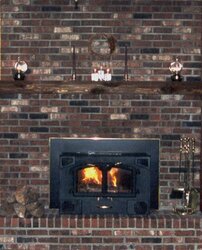Well, just taking a break from splitting up the latest load of solid gold...ur...uh, I mean hedge. The stove room has been reduced to rubble in anticipation of the upcoming remodel and I've been kicking around a thought or two. One of which is installing an electric outlet in the mantle.
It seems like we're always wanting to plug something in up there, whether it is a fan, Christmas lights, Halloween decorations, general ambiance lighting, etc. This usually means an extension cord draped across the wall from the nearest outlet. So I'm thinking why not run electricity up there and put a proper outlet right in the mantle.
My basic thought is to go through the existing wall up to the height of the mantle with normal romex, chisel a slight channel in the existing brick/mortar to hold 3/4" steel conduit which will run horizontally to an outlet box in the center of the existing mantle. The existing brick is then going to get a skin of dry stacked Montana field stone which can be relieved slightly to allow for the conduit and the mantle is going to get a skin of oak which would trim out the electric box nicely.
In short, I have a pretty good idea on how to do it, just curious if anyone had any other input or maybe someone has an outlet actually "in" the mantle and can offer suggestions / thoughts, etc.
I'm not sure exactly what building code would say (though they want you to put an outlet every couple of feet in the kitchen, so maybe the mantle is the same way?!?) But any wiring would be at least as high as the mantle and it would be in steel conduit under a stone face, so I can't see there would be any issues. I would transfer the romex into the steel conduit with the proper connectors so there wouldn't be any hidden junctions.
It seems like we're always wanting to plug something in up there, whether it is a fan, Christmas lights, Halloween decorations, general ambiance lighting, etc. This usually means an extension cord draped across the wall from the nearest outlet. So I'm thinking why not run electricity up there and put a proper outlet right in the mantle.
My basic thought is to go through the existing wall up to the height of the mantle with normal romex, chisel a slight channel in the existing brick/mortar to hold 3/4" steel conduit which will run horizontally to an outlet box in the center of the existing mantle. The existing brick is then going to get a skin of dry stacked Montana field stone which can be relieved slightly to allow for the conduit and the mantle is going to get a skin of oak which would trim out the electric box nicely.
In short, I have a pretty good idea on how to do it, just curious if anyone had any other input or maybe someone has an outlet actually "in" the mantle and can offer suggestions / thoughts, etc.
I'm not sure exactly what building code would say (though they want you to put an outlet every couple of feet in the kitchen, so maybe the mantle is the same way?!?) But any wiring would be at least as high as the mantle and it would be in steel conduit under a stone face, so I can't see there would be any issues. I would transfer the romex into the steel conduit with the proper connectors so there wouldn't be any hidden junctions.


